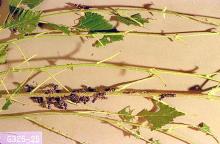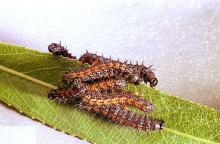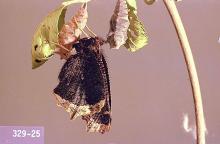Nymphalis antiopa
Pest description and damage The spiny elm caterpillar is the larval stage of the mourning cloak butterfly. The adult butterfly is approximately 2.5 inches across, with purplish brown to black wings bordered by a creamy yellow stripe and a row of blue spots. The larvae are purplish black with white specks and have a row of orange to red spots along the back and when mature approach 2.0 inches long. They have brownish prolegs and are clothed with long, forked spines. The caterpillars often feed in large groups and eat all the leaves on a branch before moving. Their feeding results in raggedly chewed leaves. Spiny elm caterpillars also feed on willow and poplar trees. This caterpillar is rarely considered a pest.
Biology and life history The adult butterfly overwinters in protected places and is found flying on warm spring days coinciding with budbreak. The females lay eggs in masses on twigs, and the larvae hatch and feed in large groups. After feeding, the mature larva pupates by suspending itself in a chrysalis from a leaf. The second generation, if there is one, emerges in August.
Management-biological control
There are several wasp parasites of the larvae. Birds will pursue and eat the adult butterfly.
Management-cultural control
Hand-pick larvae or remove heavily infested branches.
Management-chemical control
See Table 2 in:
Chemical Control of Landscape Pests
For more information
See "Caterpillar" in:



